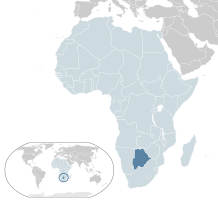
Back بوابة:بوتسوانا Arabic Portal:Botsuana Spanish Portail:Botswana French Portal:Botswana Portuguese Портал:Ботсвана Russian Портал:Ботсвана Ukrainian باب:بوٹسوانا Urdu
Intro
Botswana, officially the Republic of Botswana, is a landlocked country in Southern Africa. Botswana is topographically flat, with approximately 70 per cent of its territory being the Kalahari Desert. It is bordered by South Africa to the south and southeast, Namibia to the west and north, Zambia to the north and Zimbabwe to the northeast. Being a country of slightly over 2.4 million people and roughly the size of France, Botswana is one of the most sparsely populated countries in the world. It is essentially the nation-state of the Tswana people, who constitute 70 per cent of the population. The Tswana ethnic group were descended mainly from Bantu-speaking tribes who migrated southward of Africa to modern Botswana around AD 600. In 1885, the British colonised the area and declared a protectorate named Bechuanaland. As decolonisation occurred, Bechuanaland became an independent Commonwealth republic under its current name on 30 September 1966. Since then, it has been a parliamentary republic with a consistent record of uninterrupted democratic elections, though as of 2024 the Botswana Democratic Party has been the ruling party since independence. , Botswana is the third least corrupt country in Africa, according to the Corruption Perceptions Index published by Transparency International. The economy is dominated by mining and tourism. Botswana has a GDP (purchasing power parity) per capita of about $20,158 . Botswana is the world's biggest diamond-producing country. Its relatively high gross national income per capita (by some estimates the fourth-largest in Africa) gives the country a relatively high standard of living and the second-highest Human Development Index of continental Sub-Saharan Africa (after South Africa). Botswana is a member of the Southern African Customs Union, the Southern African Development Community, the Commonwealth of Nations, and the United Nations. (Full article...)
Selected article -The Gods Must Be Crazy is a 1980 comedy film written, produced, edited and directed by Jamie Uys. An international co-production of South Africa and Botswana, it is the first film in The Gods Must Be Crazy series. Set in Southern Africa, the film stars Namibian San farmer Nǃxau ǂToma as Xi, a hunter-gatherer of the Kalahari Desert whose tribe discovers a glass Coca-Cola bottle dropped from an aeroplane, and believe it to be a gift from their gods. When Xi sets out to return the bottle to the gods, his journey becomes intertwined with that of a biologist (Marius Weyers), a newly hired village school teacher (Sandra Prinsloo), and a band of guerrilla terrorists. The Gods Must Be Crazy was released in South Africa on 10 September 1980 by Ster-Kinekor, and broke several box office records in the country, becoming the most financially successful South African film ever produced at the time. The film was a commercial and critical success in most other countries, but took longer to find success in the United States, where it was eventually re-released in 1984 by 20th Century Fox, with its original Afrikaans dialogue being dubbed into English. Despite its success, the film attracted criticism for its depiction of race and perceived ignorance of discrimination and apartheid in South Africa. (Full article...)Did you know - ... that Chris Phatswe committed suicide by crashing his Air Botswana plane into two other planes belonging to the airline, effectively crippling operations? This is a good article, A-class article, featured list, or featured article, one of Wikipedia’s best work.
The giraffe is a large African hoofed mammal belonging to the genus Giraffa. It is the tallest living terrestrial animal and the largest ruminant on Earth. Traditionally, giraffes have been thought of as one species, Giraffa camelopardalis, with nine subspecies. Most recently, researchers proposed dividing them into four extant species due to new research into their mitochondrial and nuclear DNA, and individual species can be distinguished by their fur coat patterns. Seven other extinct species of Giraffa are known from the fossil record. The giraffe's distinguishing characteristics are its extremely long neck and legs, horn-like ossicones, and spotted coat patterns. It is classified under the family Giraffidae, along with its closest extant relative, the okapi. Its scattered range extends from Chad in the north to South Africa in the south and from Niger in the west to Somalia in the east. Giraffes usually inhabit savannahs and woodlands. Their food source is leaves, fruits, and flowers of woody plants, primarily acacia species, which they browse at heights most other ground-based herbivores cannot reach. (Full article...)General images -The following are images from various Botswana-related articles on Wikipedia.
Related portalsOther South African countriesReligion in BotswanaCategoriesAssociated WikimediaThe following Wikimedia Foundation sister projects provide more on this subject:
|
|||||||||||||||||
© MMXXIII Rich X Search. We shall prevail. All rights reserved. Rich X Search



































































